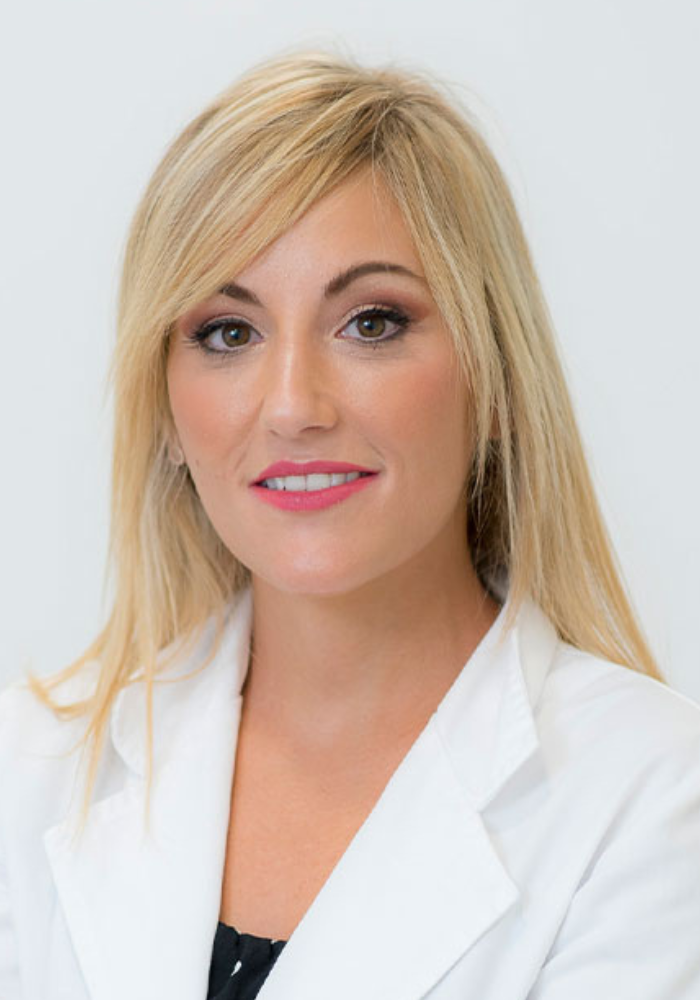
Ángela Hermosa Gelbard, MD – Featured Guest Speaker
Dermatologist, Dermatology Department, Hospital Universitario Ramón y Cajal and at Pedro Jaen´s Clinic, Madrid, Spain
Dr. Hermosa will speak on: Mesotherapy in Trichology
Dr. Hermosa-Gelbard graduated with a degree in Medicine from the Universidad Complutense de Madrid and later specialized in Dermatology at the Hospital Ramón y Cajal in Madrid. During her residency, she developed a strong interest in trichology, which led her to further pursue specialized training. She completed the International Master’s in Trichology and Hair Transplantation at the University of Alcalá, where she now serves as a a teacher and also coordinates the hair transplant training program.
Dr. Hermosa-Gelbard is part of the Hair Disorders Unit at the Grupo Pedro Jaén Clinic, working within Dr. Vañó’s team, and also at the Hair Disorders Unit of the Hospital Ramón y Cajal, where she is responsible for the Alopecia Areata specialized clinic as well. She is an active member of the Spanish Trichology Group (endorsed by the AEDV) and she is also member of the American Hair Research Society (AHRS), the European Hair Research Society (EHRS), and the International Trichoscopy Society (ITS).
Dr Hermosa-Gelbard is a co-author of the trichology handbook #TricoHRC directed by Dr. Sergio Vañó and Dr. David Saceda and has contributed to numerous scientific publications that have significantly advanced the field of trichology. Additionally, she has been involved as a researcher in several clinical trials on alopecia areata.
********************
Watch Lecture Intro Video
Summary Notes for Intro Video
Intro discussion on Dr. Ángela Hermosa’s lecture at the ISHRS World Congress: “Mesotherapy for Androgenetic Alopecia.”
Introduction:
Dr. Sam Lam, Chair for the ISHRS World Congress, speaks with Dr. Ángela Hermosa, a dermatologist, trichologist, and hair surgeon based in Madrid, Spain. Dr. Hermosa shares her expertise on mesotherapy for treating androgenetic alopecia and explains how injectable therapies—particularly with dutasteride—can complement or replace oral medications for certain patients.
Key Discussion Points:
[00:01:15] What is Mesotherapy?
Mesotherapy involves injecting specific substances directly into the scalp to promote hair regrowth. Dr. Hermosa primarily uses it for male and female androgenetic alopecia, often in combination with oral medications to enhance results or as an alternative when patients are concerned about side effects.
[00:02:00] Substances Used in Mesotherapy:
Dutasteride: Most frequently used injectable.
PRP (Platelet-Rich Plasma)
Bicalutamide
Minoxidil: Less commonly used due to pain and short half-life.
Combination therapies are possible, with substances injected separately in the same session.
[00:03:30] Injectable vs. Oral Dutasteride:
Injectable dutasteride is a good option for patients avoiding systemic medication.
In severe cases, both oral and injectable forms can be used together to maximize results.
[00:04:45] Frequency of Dutasteride Injections:
Initial Phase: Every 3 months.
Maintenance Phase (after 1 year): Reduced to twice a year, depending on patient response.
[00:06:00] Safety and Side Effects:
No systemic side effects reported with injectable dutasteride.
The most common side effect is pain, which can be managed with local anesthesia.
[00:07:15] Minoxidil Injections:
Minoxidil Injections are rarely used due to pain and required frequency (every 2 weeks).
It is occasionally requested during anesthetized sessions, but oral/topical minoxidil is generally preferred for ease of use.
[00:08:00] Other Substances in Mesotherapy:
Stem Cells (Regenera): Effective but costly, so used less frequently.
Vitamins/Exosomes: Not part of Dr. Hermosa’s usual protocol.
Dr. Hermosa’s Notable Quotes:
“In my experience, oral dutasteride is more effective than injected dutasteride. But mesotherapy with dutasteride improves the results of oral dutasteride.” [00:03:45]
“Here in Spain, it’s very typical that patients are very concerned about potential side effects of oral dutasteride. In those cases, I combine oral dutasteride three times per week with mesotherapy to improve results.” [00:05:15]
“The most frequent side effect of mesotherapy with dutasteride is pain. I usually perform local anesthesia before making the procedure, and in this way, the procedure is very well tolerated.” [00:06:15]
Conclusion:
This conversation offers an introduction into mesotherapy’s role in treating androgenetic alopecia. Dr. Hermosa provides some practical guidance for incorporating injectable treatments into clinical practice, especially for patients hesitant about oral medication.
Don’t miss her full presentation at the ISHRS World Congress taking place in Berlin, Germany, from October 23 to 25, 2025 and explore the latest advancements in hair restoration therapies.